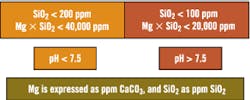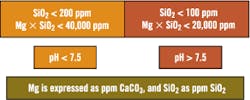Water Treatment'sGordian Knot'
The solubility of amorphous silica is important to the operation of water-dominated production processes. In areas such as Texas, New Mexico, Arizona, parts of California, southern Europe, the Pacific Rim and Latin America, the water used for industrial applications contains high silica concentrations (50 parts per million [ppm] to 100 ppm, expressed as silicon dioxide [SiO2]). These concentrations result from quartz (crystalline SiO2) dissolution from rock formations into the groundwater.
The potential for silica-scale deposition poses serious problems in water with a high dissolved silica content. In fact, silica-scale problems could be termed the Gordian Knot of water treatment ," such problems are extremely difficult to resolve. Personnel responsible for power plants, evaporative cooling systems, semiconductor manufacturing and geothermal systems must monitor water silica levels very closely.
Silica precipitation/deposition frequently is encountered in evaporative cooling systems, where salt concentrations increase through partial evaporation of the cooling water. Silica solubility in water generally is 150 ppm to 180 ppm, depending on water chemistry and temperature. This imposes severe limits on water users, leading either to operation at very low cycles of concentration and consuming enormous amounts of water, or to use of chemical water treatment techniques that prevent silica-scale formation and deposition.
Silica and/or silicate deposits are particularly difficult to remove once they form. Harsh chemical cleaning (based on hydrofluoric acid) or laborious mechanical removal usually is required. In addition, the potential for silica scale with high calcium and magnesium levels limits the use of polysilicate as a steel and aluminum inhibitor, especially in low-hardness cooling waters.
Silica speciation and deposition
Silica-scale formation is a highly complex process. It is usually favored at a pH of less than 8.5, whereas magnesium silicate scale forms at a pH of more than 8.5. Data suggest silica solubility is largely independent of pH in the range of 6 to 8. Silica exhibits normal solubility characteristics, which increase proportionally to temperature. In contrast, magnesium silicate exhibits inverse solubility.
Silica formation is actually a polymerization event. When silicate ions polymerize, they form a plethora of structural motifs, including rings of various sizes, cross-linked polymeric chains of different molecular weights, oligomeric structures, etc. The resulting silica scale is a complex and amorphous product (colloidal silica) ," a complicated mixture of the above components.
Operation in a high-pH regime is not necessarily a solution for combating silica scale. Water system operators must take into account the presence of magnesium (Mg2+) and other scaling ions such as calcium (Ca2+). A pH adjustment to greater than 8.5 might result in massive precipitation of magnesium silicate if high levels of Mg2+ are present or in calcium carbonate (CaCO3)or calcium phosphate if high levels of these ions are overlooked.
Silica precipitation also can be aggravated by the presence of metal ions such as iron (Fe2+/3+) or aluminum (Al3+) and their hydroxides. Corroded steel surfaces (e.g., on pipes or heat exchangers) are very prone to silica fouling. Iron oxides/hydroxides act as deposition matrices for silica (either soluble or colloidal) deposits.
General Treatment Guidelines for Silica-Scale Control
Silica-scale control
Current practices for combating silica-scale growth in industrial waters include operation at low cycles of concentration, prevention of other-scale formation, pretreatment and inhibitor or dispersant use.
Operation at low cycles of concentration
Keep in mind that Mg2+ levels also should be taken into account at a pH level greater than 7.5. In this case, the product (ppm Mg as CaCO3) 3 (ppm SiO2 as SiO2) should be below 20,000 ppm. The figure gives additional rules-of-thumb for silica-bearing process waters.
is a common practice, but one that consumes large amounts of water. In a cooling tower operating at a pH of less than 7.5, silica generally should be maintained below 200 ppm (as SiO2). For a pH greater than 7.5, silica should be maintained below 100 ppm (as SiO2).Prevention of other-scale formation
Pretreatment
indirectly interferes with the propensity of silica scale to co-precipitate with other scales. The method is based on prevention of other scaling species such as CaCO3 or calcium phosphate and indirectly benefits the whole cooling tower operation. CaCO3 precipitates provide a crystalline matrix in which silica can be entrapped and grow. In environments in which CaCO3 or any other mineral precipitate is prevented completely, higher silica levels generally are tolerated in the process water than in those environments in which other scales are controlled ineffectively (Gill, 1998).In addition, silica can be removed through reverse osmosis (RO) and ion exchange techniques, as well as desilicizers. RO membranes are not immune to silica scale, which forms as a gelatinous mass on the membrane surface. It then can dehydrate, forming a cement-like deposit.
The use of inhibitors or dispersants
involves reactive or colloidal silica removal in precipitation softeners through an interaction between silica and a metal hydroxide. Both iron hydroxide, Fe(OH)3, and aluminum hydroxide, Al(OH)3, have shown silica-removal capabilities, although magnesium hydroxide, Mg(OH)2, is considered more effective.Dispersion, on the other hand, is the prevention of particle agglomeration to form larger-size particles and the prevention of the adhesion of these particles onto surfaces.
A number of products are available commercially for silica-scale control in RO, geothermal and evaporative cooling water applications. Discussion of these products is not the intent of this article. However, much information about commercial silica-scale treatment can be found on the Web through any of the popular search engines. In addition, several proprietary technologies can be found in patent literature.
to control silica scale generally follows two approaches: inhibition and dispersion. Inhibition is defined as the prevention of silica oligomerization or polymerization. As a result, the silica remains soluble and, therefore, reactive.Mechanism of silica-scale inhibition
Amorphous silica formation is governed by several equilibria. Silica deposition results from silicic acid self-condensation. This reaction is first-order and is catalyzed by OH- in the pH range of 5 to 10. Reports have shown that the reaction yielding a silicic acid dimer is kinetically slow in contrast to the reactions giving a trimer, tetramer, pentamer, etc., which are very fast. All these equilibria are very sensitive to pH and tend to be accelerated by metal ions that form hydroxides, e.g., Fe2+, Mg2+ or Al3+.
Polymerization of silicic acid is believed to occur through a mechanism involving a deprotonated silicon monoxide (Si-O-) and the Si center of silicate, Si(OH)4. Inhibition of this step should be critical in the inhibition of silica-scale formation. Some reports indicate that orthosilicates hydrolyze more rapidly than other silicate species such as disilicates, chain silicates, cross-linked oligomers and polymers, suggesting that bridging oxygens are much more resistant to attack than nonbridging oxygens. Above a pH of 2, this mechanism involves polymerization with condensation, catalyzed by OH-.
Silica-scale formation involves condensation between Si-OH groups formed at the material surface and Si-OH of the dissolved silicate present in water. Condensation between the Si-OH units formed at a glass surface and dissolved Si-OH can be the dominant mechanism (Hayakawa, et al.).
Silica polymerization is governed largely by pH. Unfortunately, silica is a foulant not easily cured through pH adjustments. For example, CaCO3 scale virtually can be eliminated if a cooling tower system is operated at a lower pH. With water containing a high concentration of silica, operation at a higher pH generates the problem of magnesium silicate scale. Lowering the pH (by feeding acid) does not eliminate the problem; it just shifts it from magnesium silicate to silica.
A low operational pH also increases the corrosion rates of metallic surfaces, ultimately leading to material failure. Silica solubility is very high at a pH greater than10, but this pH regime is not an operational option for cooling tower systems.
Dissolved silica precipitates out of solution principally in three ways: through surface deposition, through bulk precipitation or in living organisms.
Surface deposition.
Bulk precipitation.
This occurs as a deposit on a solid surface where the [Si(OH)4-x]x- condenses with any solid surface possessing -OH groups. If the surface contains M-OH moieties (M = metal), this reaction is enhanced further. Such pronounced silica deposition phenomena in the water treatment industry are evident on metallic surfaces that have suffered severe corrosion, with a surface covered with metal oxides/ hydroxides. Once the receptive surface is covered with silica scale, additional silica is deposited on an already-formed silica film.In living organisms.
The precise mechanism of silica formation is not well understood. Any interference with the condensation reaction could lead to silica-scale growth inhibition. A relevant example is silica inhibition by orthoborate, which reacts with silicate ions to form borosilicates. These products are more soluble in water than are silica/metal silicates.
This occurs as colloidal silica particles grow through the condensation reaction. The particles collide with each other and agglomerate, forming larger particles.Silica-scale inhibition monitoring
Any chemical treatment program req-uires proof of its performance. For example, programs to control CaCO3 are monitored by measuring Ca hardness in the recirculating water and by comparing the measured and theoretical amounts. Inhibitor levels also are monitored closely to ensure the presence of sufficient inhibitor and dispersant polymer.
This form of silica is called biogenic and appears in certain microorganisms such as diatoms that have the ability to remove and deposit silica from highly undersaturated solutions into precisely controlled structures of intricate design. It should be mentioned that sessile microorganisms in a biofilm-fouled heat exchanger can entrap colloidal silica. The high affinity of soluble silica toward exocellular biopolymers such as polysaccharides has been recognized (Gill, 1998).For silica, an easy field test is based on the silicomolybdate method. This method is based on a yellow complex that forms between molybdate and silicate under certain conditions and can be measured spectrophotometrically.
Phosphate can interfere with the measurement by forming a similar complex with molybdate. Its interference can be eliminated by the action of oxalic or citric acid.
The silicomolybdate test measures soluble (reactive) silica. It does not measure colloidal silica. It is worth noting that reactive silica does not refer to only monomeric silica (silicate ion). It also includes other oligomeric species such as dimers, trimers, tetramers, etc.
For all practical purposes, the silicomolybdate test offers a good indication of the soluble silica in the system. However, occasional measurements of total silica ," i.e., soluble and colloidal ," are recommended to ensure no silica is lost to precipitation and deposition. These measurements require sample treatment or elaborate instruments and techniques (e.g., inductively coupled plasma atomic emission or atomic absorption spectroscopy) and are not practiced routinely in the field. Samples usually are sent to an independent laboratory for study.
Conclusions
Silica is an undesirable scale for several reasons. It severely impedes heat transfer. It is tenacious and costly (and potentially hazardous) to remove. It is extremely prone to co-precipitation with other scales, particularly iron (hydr)oxides. It is often the limiting factor for limiting high cycles of concentration.
The amorphous character of silica deposits precludes the use of conventional crystal modification technologies. Molecules such as phosphonates that are effective mineral-scale threshold inhibitors provide virtually no benefit for silica-scale inhibition. They provide only an indirect benefit by maintaining a cooling tower free of other deposits that can act as precipitation nuclei for silica or catalyze silica precipitation in the bulk.
Just like the Gordian Knot ," the difficult, intractable and often insolvable problem ," resolution of the silica problem might require nonconventional means. Several factors, unique to the individual system, must be taken into consideration. These factors include water chemistry (presence of other scaling ions), nature of the silica (colloidal and/or reactive) in the make-up water, target cycles of concentration (need for water conservation), feasibility of mechanical silica removal (filtration and softening), capital costs (for chemicals and/or equipment) and many others. Careful selection of a general scale treatment program, combined with a silica-scale inhibitor and/or dispersant, is a good starting point for attaining a silica deposit-free cooling water system.
|
Bibliography 1. American Public Health Association, Standard Methods for the Examination of Water and Wastewater, 19th Ed., 1995, pp. 4,"18. 2. Andersson, K.R. et al. Soluble Silicates, American Chemical Society (ACS) Symposium Series, 1982, p. 115. 3. Bergna, H.E. The Colloidal Chemistry of Silica, ACS Symposium Series, 1994, p. 1. 4. Bremere, I. et al. Proceedings of the Conference on Membranes in Drinking and Industrial Water Production, Vol. 2, 2000, p. 129. 5. Chan, S.H. et al. Journal of Heat Transfer, Vol. 117, 1995, p. 323. 6. Daniels, D. Power, September 2002, p. 43. 7. Dubin, L. Surface Reactive Peptides and Polymers, ACS Symposium Series, 1991, p. 354. 8. Gallup, D.L. Geothermal Resources Council Transactions, Vol. 21, 1997, p. 49. 9. Gill, J.S. Materials Performance, Vol. 37, November 1998, p. 41. 10. Hann, W.M. et al. 1993 International Water Conference Proceedings, Paper 59, p. 358. 11. Harfst, W. Ultrapure Water, April 1992, p. 59. 12. Hayakawa, S. et al. Journal of the American Ceramic Society, Vol. 82, 1999, p. 2155. 13. Henley, M. Ultrapure Water, December 1992, p. 13. 14. Hennis, S. et al. Chemical Processing, Vol. 64, June 2001, p. 32. 15. Iler, R.K. The Chemistry of Silica, Wiley-Interscience, New York, 1979. 16. Kristmannsdottir, H. et al. Geothermics, Vol. 18, 1989, p. 191. 17. Masarwa, A. et al. Desalination, Vol. 113, 1997, p. 73. 18. Midkiff, W.S. and H.P. Foyt. Materials Performance, February 1978, p. 17. 19. Radzig, V.A. Colloids and Surfaces: Physicochemical and Engineering Aspects, Vol. 74, 1993, p. 91. 20. Reay, P.F. and W.D. Bennett. Analytica Chimica Acta, Vol. 198, 1987, p. 145. 21. Schenk, J.E. and W.J. Weber Jr. Journal of the American Water Works Association, February 1968, p. 199. 22. Smith, C.W. Industrial Water Treatment July/August 1993, p. 20. 23. Tatterson, G. Chemical Processing, Vol. 65, January 2002, p. 12. 24. Weres, O., A. Yee and L. Tsao. Journal of Colloid and Interface Science, Vol. 84, 1981, p. 379. 25. Wibowo, J. et al. Semiconductor Pure Water and Chemicals Conference Proceedings, 1997, p. 43. |
Demadis is an assistant professor of chemistry at the University of Crete in Greece. He has extensive experience in chemical water treatment research and development and also in technical and field support. Contact him +3 2810 393651, or via e-mail at [email protected].


